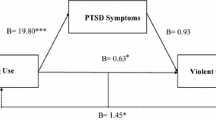Abstract
Trauma exposure and trauma-related symptoms are prevalent among incarcerated men, suggesting a need for behavioral health intervention. A random sample of adult males (N = 592) residing in a single high-security prison were screened for trauma exposure and posttraumatic stress disorder (PTSD) symptoms. Trauma was a universal experience among incarcerated men. Rates of current PTSD symptoms and lifetime PTSD were significantly higher (30 to 60 %) than rates found in the general male populations (3 to 6 %). Lifetime rates of trauma and PTSD were associated with psychiatric disorders. This study suggests the need for a gender-sensitive response to trauma among incarcerated men with modification for comorbid mental disorders and type of trauma exposure. Developing gender-sensitive trauma interventions for incarcerated men and testing them is necessary to improve the behavioral health outcomes of incarcerated men who disproportionately return to urban communities.

Similar content being viewed by others
References
Fazel S, Danesh J. Serious mental disorder in 23,000 prisoners: a systematic review of 62 surveys. Lancet. 2002; 359: 545–550.
James DJ, Glaze LE. Mental Health Problems of Prison and Jail Inmates. Washington, District of Columbia, U.S. Dept of Justice; 2006. NCJ 213600
Harlow C. Prior Abuses Reported by Inmates and Probationers. Washington, District of Columbia, U.S. Dept of Justice; 1999. NCJ 172879
Wolff N, Shi J, Siegel J. Patterns of victimization among male and female inmates: evidence of an enduring legacy. Violence Vict. 2009; 24: 469–484.
Wolff N, Blitz CL, Shi J, Bachman R, Siegel J. Sexual violence inside prison: rates of victimization. J Urban Health. 2006; 83: 835–848.
Wolff N, Shi J. Trauma and incarcerated persons. In: Scott CL, ed. The Handbook of Correctional Mental Health. 2nd ed. Arlington, VA: American Psychiatric Publishing; 2009: 277–320.
Mumola CJ, Karberg JC. Drug Use and Dependence, State and Federal Prisoners, 2004. Washington, District of Columbia, U.S. Dept of Justice; 2006. NCJ 213530
Chandler RK, Fletcher BW, Volkow ND. Treating drug abuse and addiction in the criminal justice system: improving public health and safety. JAMA. 2009; 301: 183–190.
Breslau N. The epidemiology of trauma, PTSD, and other postrauma disorders. Trauma Violence Abuse. 2009; 10: 198–210.
Gibson LE, Holt JC, Fondacaro KM, et al. An examination of antecedent traumas and psychiatric comorbidity among male inmates with PTSD. J Trauma Stress. 1999; 12: 473–484.
Saxon AJ, Davis TM, Sloan KL, et al. Trauma, symptoms of posttraumatic stress disorder, and associated problems among incarcerated veterans. Psy Ser. 2001; 52: 959–964.
Teplin L, McClelland GM, Abram KM, et al. Crime victimization in adults with severe mental illness: comparison with the National Crime Victimization Survey. Arch Gen Psychiatry. 2005; 62: 911–921.
Wilkins KD, Lang AJ, Norman SB. Synthesis of the psychometric properties of the PTSD checklist (PCL) military, civilian, and specific versions. Depress Anxiety. 2011; 28: 596–606.
Keen SM, Kutter CJ, Niles BL, et al. Psychometric properties of PTSD Checklist in sample of male veterans. J Rehabil Res Dev. 2008; 45: 465–474.
Green B. Trauma history questionnaire. In: Stamm BH, ed. Measurement of Stress, Trauma, and Adaptation. Lutherville, MD: Sidran Press; 1996: 366–369.
Hooper LM, Stockton P, Krupnick JL, et al. Development, use, and psychometric properties of the trauma history questionnaire. J Loss Trauma. 2011; 16: 258–283.
Tjaden P, Thoennes N. Full Report of the Prevalence, Incidence, and Consequences of Violence Against Women: Findings from the National Violence Against Women Survey. Washington, District of Columbia: National Institute of Justice and Centers for Disease Control and Prevention; 2000. NCJ 183781
Blake DD, Weathers FW, Nagy LN, et al. A clinician rating scale for assessing current and lifetime PTSD: the CAPS-1. Behav Ther. 1990; 13: 187–188.
First MB, Spitzer RL, Gibbon M, et al. Structured Clinical Interview for DSM-IV-TR Axis I Disorders, Research Version, Patient Edition with Psychotic Screen. New York, Biometrics Research, New York State Psychiatric Institute, Nov 2002
Weathers FW, Litz BT. Psychometric properties of the Clinician-Administered PTSD Scale, CAPS-1. PTSD Res Q. 1994; 5: 2–6.
Grubaugh AL, Magruder KM, Waldrop AE, et al. Subthreshold PTSD in primary care: prevalence, psychiatric disorders, healthcare use, and functional status. J Nerv Ment Dis. 2005; 193: 658–664.
Elhai JD, Gray MJ, Kashdan TB, et al. Which instruments are most commonly used to assess traumatic event exposure and posttraumatic effects? A survey of traumatic stress professionals. J Trauma Stress. 2005; 18: 541–545.
Weathers FW, Litz BT, Herman DS, et al. The PTSD Checklist (PCL): reliability, validity, and diagnostic utility; in Proceedings of the Annual Conference of the International Society for Traumatic Stress Studies. San Antonio, TX, Oct 1993
Breslau N, Chilcoat HD, Kessler RC, et al. Vulnerability to assaultive violence: further specification of the sex difference in post-traumatic stress disorder. Psychol Med. 1999; 29: 813–821.
Lukaschek K, Kruse J, Thwing Emeny R, et al. Lifetime traumatic experiences and their impact on PTSD: a general population study. Soc Psychiatry Psychiat Epidemiol. 2013; 48: 525–532.
Wolff N, Frueh BC, Shi J, et al. Trauma exposure and mental health characteristics of incarcerated females self-referred to specialty PTSD treatment. Psy Ser. 2011; 62: 954–958.
Price M, Higa-McMillan C, Kim S, et al. Trauma experience in children and adolescents: an assessment of the effects of trauma type and role of interpersonal proximity. J Anxiety Disord. 2013; 27: 652–660.
Federal Partners Committee on Women and Trauma: Trauma-informed approaches: Federal activities and initiatives. Washington: DC. September 2013. Available at http://nicic.gov/Library/027657
Acknowledgments
This study was supported by grant R01-MH095206 from the National Institute of Mental Health
Author information
Authors and Affiliations
Corresponding author
Rights and permissions
About this article
Cite this article
Wolff, N., Huening, J., Shi, J. et al. Trauma Exposure and Posttraumatic Stress Disorder among Incarcerated Men. J Urban Health 91, 707–719 (2014). https://doi.org/10.1007/s11524-014-9871-x
Published:
Issue Date:
DOI: https://doi.org/10.1007/s11524-014-9871-x




